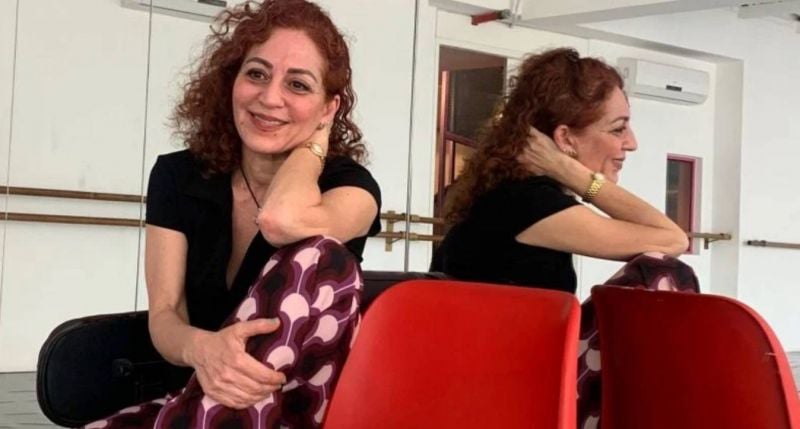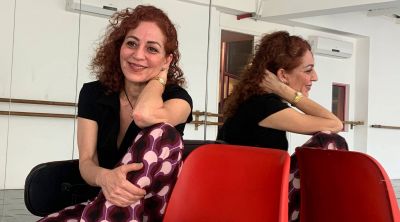
(Courtesy of Nada Kano)
Who is Nada Kano, the person and artist?
I’m a dance teacher and choreographer. I am what I do. Dance defines me completely, I’ve given everything for it, it’s the center of my life.
Tell us about your L'Étreinte Choreography show. It was created a few years ago, so why did you choose to present it this year in Beirut?
Yes, it’s a show that was created in 2011. It was presented several times in 2011, in 2016 and in 2021 in Dubai. This year, in January 2023, I made my big return to Lebanon [for the first time] since 2018. I only have two dancers left in my troupe this year, so I have to do duets.
What did you want to create with this show?
In fact, L'Étreinte is a love story told from beginning to end. The encounter is represented at the beginning by a table representing the distance, a barrier between them. As the play goes by, they grow closer until they merge. It’s a very simple piece that describes the evolution of a relationship. I made it very spontaneously, inspired by the writings of Spinoza.
You dance at Le Monnot Theatre in the 90s, then in January and June 2023 you presented your creations there again. How do you feel about this return 30 years later?
It’s very sentimental, of course. It’s like home, because I was there from the start, even if I’m more attached to the al-Madina Theatre, which is better suited to dance. But it has to be said that we have very few theaters in Beirut, and the Monnot Theatre is the only one in Achrafieh. We’re emotionally attached to all the theaters in Beirut.
You come from a classical background, but you claim to have a contemporary influence. In your work, however, classical influences are everywhere, in the steps, the structure and the music. Where do you position yourself?
I’ve always found it hard to define my work, and I don’t really think about it too much. I allow myself total freedom in my creative process. Of course, music plays a big part and gives a color, but sometimes I use very classical music with very contemporary movements, and vice versa. But I find that the boundaries between the two genres are becoming increasingly blurred.
How do you manage your dual French-Lebanese identity in your art? Why did you choose to return to Lebanon?
I actually did 15 years of dance training in France, which explains my Western influences today in my technique. I admire the French technique, which is very refined. I think that my work today has a Western form in terms of technique and a Mediterranean background, a bubbling emotional excess.
After my training, I returned to Lebanon, with difficulty, but with the aim of creating something that didn’t exist in the country. When I was younger, I had suffered from not being able to find a complete dance training course in Lebanon. So I set up this school, one of the first in the country, which has grown into a dance troupe. I’ve never stopped having links with France, I’ve always collaborated with French choreographers and dancers like Marie-Agnès Gillot, but always in a spirit of liaison with Lebanon. My artistic life in France exists thanks to Lebanon. Without creation in Lebanon, my visibility in France disappears.
How are you coping with your return to the Beirut scene after several years’ absence?
It’s been very hard. Because of the crisis, because of the lack of funding, because of the Lebanese dancers who have all left. At the moment, there are only two dancers left in the troupe. Everyone else has left. Before, things were different.
What’s your take on this new post-crisis artistic momentum that’s taking place in the country at the moment?
From what I can see, it’s coming back even stronger than before the crisis. I think there’s a relentlessness about it. I don’t know if it’s a need to express oneself, if it’s an act of resistance. Now, culture remains very limited in terms of resources, especially in dance. It’s more complex, because dance training is very long. It takes 10 years to be a dancer. And there’s the problem of a country that’s been emptied of young people. Even before the crisis, dance was a bit difficult. We mustn’t forget that we don’t have a dance academy, we don’t have grants, we have nothing. I’ve been fighting the battle for dance since 2003.
My reference point was before 2018, when there was a huge audience for dance. And today, I’ve never seen anything like it, I feel like I’m starting all over again. I feel like I’m rediscovering everything, looking for it, seeing it all again. Everything is new. The audience is new. The way things work is new. I’m in a state of observation and reflection at the moment. I don’t think I’m the only one, everyone’s groping around.
Do you find, as many do, beauty in Lebanese resilience? Of always wanting to move forward and rebuild after a crisis, particularly artistically?
It’s true that the Lebanese people have this resilience, and everyone says so. But I think they have perhaps a little too much. This resilience is extraordinary, but at the same time we can’t avoid solving our problems. You have to face up to things in order to overcome them. It’s good to get back up but, at the same time, this resilience must not be a semblance of “everything’s fine.” For me, it’s simply a survival instinct. We're traumatized and broken people, and we need to look after ourselves.
With this crisis for dance in Lebanon, how do you see the future of your school?
I only have 15 students now, compared with 150 last year, and only two dancers in my troupe. They are brilliant and I hired them in 2009 as part of my project to teach dance to children from disadvantaged backgrounds. Since 2009, I have trained them along with around 20 other children. In 2018, all but these two left the course. Today, I can no longer afford to continue, so I’ve given myself this year to make a decision. But it’s been such a long and difficult road to get to this point... It’s very hard for me to make a decision, but I don’t know how long I’ll be able to hold out. It’s been a dramatic year for me. I’m currently looking for solutions. Going to Dubai, coming back to France... but I wouldn’t like that.
This article was originally published in French in L'Orient-Le Jour. Translation by Joelle El Khoury.

